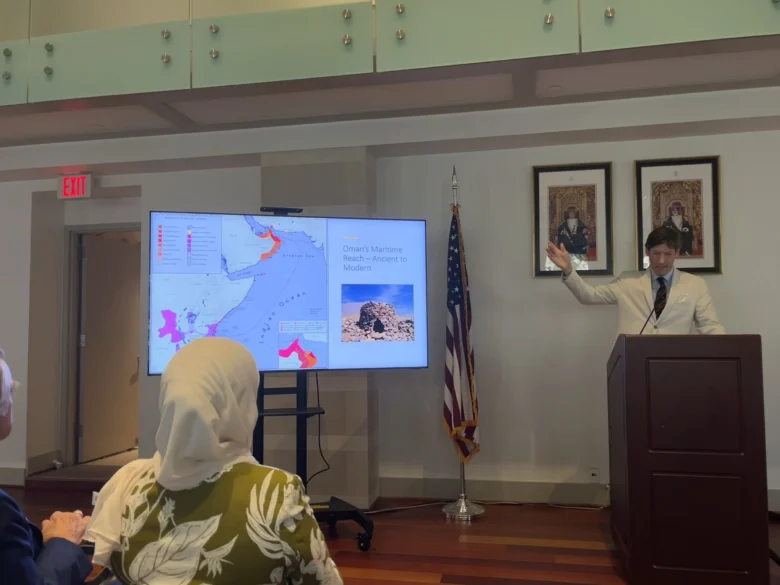In a lecture at the Sultan Qaboos Cultural Center, Dr. Allen Fromherz, author of The Center of the World, argued that the Persian Gulf has not only been central to world history but has also played a crucial role in trade and cultural development.
In a wide-ranging discussion that included a question-and-answer session, Fromherz examined Oman’s importance to Middle Eastern history, emphasizing the region’s geography, cultural traditions, and political patterns that allowed the Gulf to avoid complete domination by imperial powers.
Opening remarks were delivered by Dr. Majid Al Khalili, executive director of the cultural center. After some light-hearted remarks about historians who struggle to narrow their focus, Al Khalili acknowledged the depth and breadth of Fromherz’s scholarship.
Using photographs of relevant cultural artifacts and landmarks, Fromherz described a distinctive cultural dynamic in Oman.
“The people of the Gulf as a whole have managed to square the circle of identity,” Fromherz said. “How can you be in a cosmopolitan sense, inspired by others, but also maintain identity? This is [where] I think the Gulf shows their own distinctive cosmopolitanism because they are able to maintain distinctive cultural identities along the Gulf, even though people of the Gulf have moved in vast distances across the ocean.”
Fromherz’s book is structured around key Gulf ports that shaped the region’s development. In the lecture, he moved fluidly from the ancient trading center of Dilmun to Basra, then to Siraf in the Medieval Gulf, concluding with the Strait of Hormuz.
The consistent thread across these periods was Oman’s central role in maritime trade. From supplying copper and diorite during the earliest phases of international trade with Dilmun to becoming a nation whose population is now largely composed of foreign nationals, Oman has remained integral to the Gulf’s historical and economic trajectory.
Fromherz noted a compelling contrast: while agriculture historically anchored most economies, Oman followed a different model. Trade and commerce, rather than farming, shaped the Gulf’s economic identity—setting it apart from nearby imperial centers.
With a relaxed and humorous tone, Fromherz connected with the audience through relatable anecdotes as he discussed the region’s major ports. He compared brief conversations with strangers on airplanes to the more immersive relationships formed aboard trading ships centuries ago.
“You had to become friends with people very different from you, you know. You couldn’t just sleep the whole time. You had to find a place to practice, to pray the way that you pray versus the way that they pray,” Fromherz said. “That experience of being on the ship, I think embodies—and of course you’re subject to the same winds, the same storms, you’re subject to the same fate—I think embodies that kind of cosmopolitan experience from people leaving and coming back to the Gulf constantly.”
Challenging conventional assumptions, Fromherz summarized several arguments from his book. He refuted the idea that Siraf, during its height in the Medieval Gulf, was eclipsed by the Red Sea. Instead, he asserted the Gulf remained a vital commercial and cultural corridor, supported by evidence from Jewish traders, as well as period legends and oral histories.
He also addressed Portuguese influence in the region. While neighboring areas experienced colonization, Fromherz contended that Oman’s case was distinct. Rather than being fully subjugated, Omani society and the broader Gulf system had a transformative effect on the Portuguese.
“[The Gulf system] prioritized lower custom duty, getting as many merchants as possible. It wasn’t about agriculture, it was about trade. And [the Portuguese] caught on to this very quickly. So when the inquisition happened, they went to Brazil. It stopped before getting to Hormuz,” Fromherz said. “There were a couple attempts to destroy mosques and churches, but these were quickly reversed on the orders of the king of Portugal himself, because he knew it would destroy the font of silver coming from Hormuz.”
Throughout his presentation, Fromherz made a compelling case for the Gulf’s longstanding relevance. His clear and accessible explanations brought historical complexity into focus, underscoring the enduring importance of Oman and the Gulf.
“It’s not that the Gulf has suddenly become like the rest of the world. It’s that the rest of the world has become like the way the Gulf was, and always has been,” Fromherz said.
